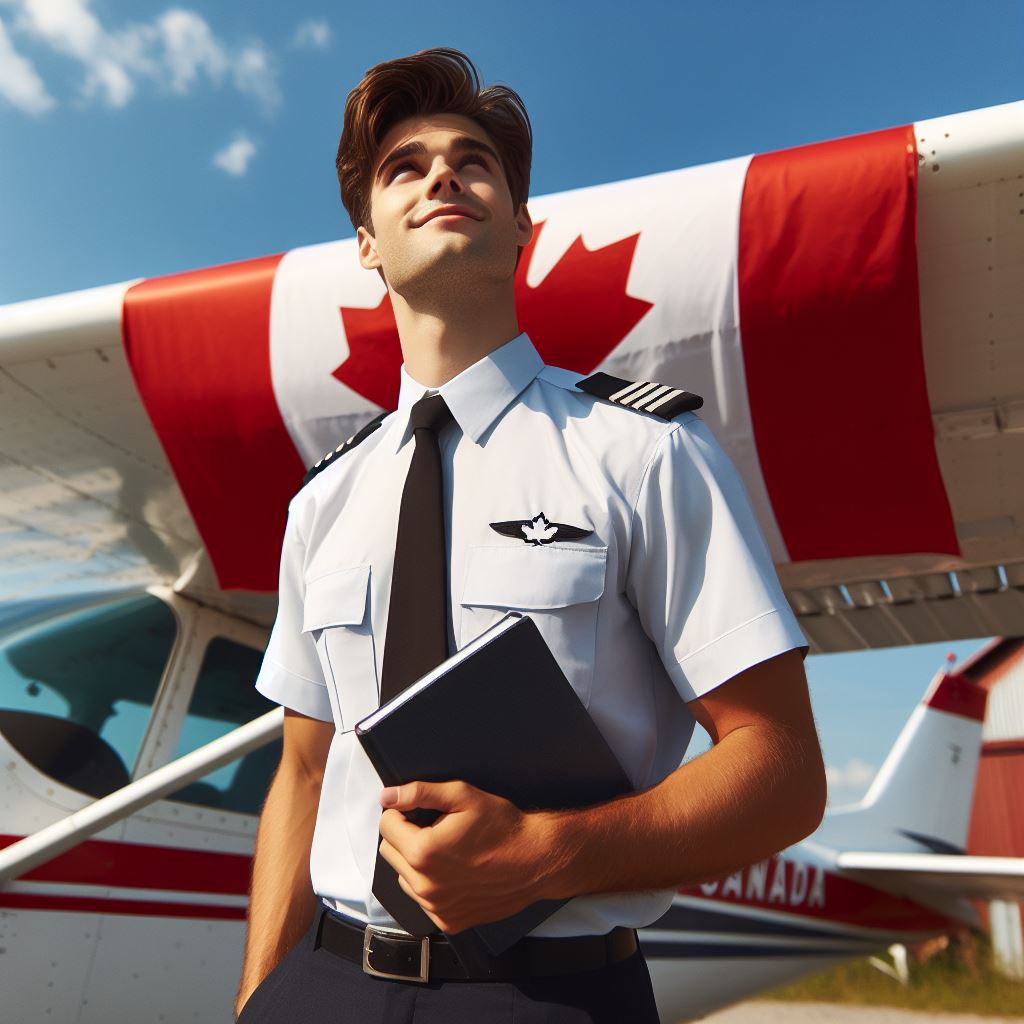Introduction
In Canada, pilot career progression is an essential aspect that all aspiring pilots need to understand.
It involves the systematic advancement and growth within the aviation industry.
Having a clear understanding of this progression is vital for pilots aiming for success in their careers.
Pilot career progression refers to the step-by-step advancement in a pilot’s professional journey.
It starts with obtaining the necessary licenses and ratings, such as the Private Pilot License (PPL) and the Airline Transport Pilot License (ATPL).
As pilots gain more experience, they can move up to more advanced aircraft and positions, such as First Officer and Captain.
Understanding pilot career progression in Canada is crucial for several reasons.
Firstly, it helps aspiring pilots set clear goals and create a roadmap for their professional development.
By knowing the necessary steps and requirements, they can plan their training and gain the necessary qualifications.
Secondly, understanding career progression enables pilots to make informed decisions about their training and job opportunities.
They can choose the right flight school and training programs that align with their career goals.
Additionally, they can make strategic choices regarding their employment, considering factors such as salary, career growth prospects, and work-life balance.
Lastly, understanding career progression helps pilots navigate the industry effectively and seize opportunities for advancement.
By knowing the typical path followed by successful pilots, they can proactively seek out mentorship, networking, and additional training to enhance their skills and increase their chances of progression.
In short, pilot career progression in Canada plays a vital role in a pilot’s journey to success.
By understanding this progression, aspiring pilots can set goals, make informed decisions, and navigate the industry effectively for long-term professional growth.
Initial Training and Licenses
Obtaining the necessary training and licenses is a crucial step towards a successful pilot career in Canada.
The aviation industry in Canada is highly regulated to ensure the safety and competency of its pilots.
Whether you dream of flying a small plane or becoming an airline captain, the process starts with meeting the requirements for becoming a pilot.
Requirements for becoming a pilot in Canada
Firstly, you must be at least 18 years old and either a Canadian citizen or permanent resident.
Additionally, you need to hold a valid Class 1 or Class 3 medical certificate issued by Transport Canada.
This ensures that you are in good health and fit to fly.
As for flight experience, you must accumulate a minimum of 200 hours of flight time, with at least 100 hours as a pilot-in-command.
This experience allows you to gain the necessary skills and knowledge to become a competent pilot.
Moreover, having a high school diploma or equivalent educational qualification is also required.
Unlock Your Career Potential
Visualize a clear path to success with our tailored Career Consulting service. Personalized insights in just 1-3 days.
Get StartedTypes of pilot licenses
There are different types of pilot licenses available in Canada, each granting specific privileges and responsibilities.
The Private Pilot License (PPL) is the first step for most aspiring pilots. It permits flying for non-commercial purposes and carrying passengers.
With a Commercial Pilot License (CPL), you can fly for hire or reward, opening up opportunities for employment or starting your own aviation business.
The Airline Transport Pilot License (ATPL) is the highest level of qualification and is mandatory for those aspiring to serve as captains or first officers in commercial airlines.
Process of obtaining necessary training and licenses
To obtain these licenses, aspiring pilots must follow a prescribed process.
Initially, enrolling in a flight school approved by Transport Canada and completing ground school training is necessary.
Ground school training covers theoretical aspects such as meteorology, navigation, and aviation regulations.
Once ground school training is completed, you need to pass written exams for each license.
These exams are comprehensive, testing your knowledge in various subjects related to aviation.
The next step is flight training, where you accumulate the required flight hours specified for each license.
Flight training involves both dual instruction with an instructor and solo flights to hone your skills.
The final step in the licensing process is successfully passing a flight test conducted by a Transport Canada examiner.
The flight test assesses your ability to apply the knowledge and skills acquired during training in real-world scenarios.
It covers areas such as pre-flight planning, aircraft control, navigation, emergency procedures, and communication.
Once you have obtained the necessary training and licenses, a world of opportunities opens up.
You can pursue a career as a flight instructor, pursue a corporate pilot job, or even aim for the coveted position of an airline captain. The sky is the limit!
Overall, the journey from initial training to obtaining the required pilot licenses in Canada involves dedication, hard work, and a passion for aviation.
However, the rewards of a fulfilling and exhilarating career in the skies make every step worthwhile.
Read: Regional vs. International Pilots
Building Hours and Gaining Experience
When it comes to pilot career progression in Canada, building flight hours and gaining experience are crucial steps.
Flight hours play a significant role in pilot career advancement, and there are various ways to accumulate them in Canada.
Importance of Flight Hours in Pilot Career Progression
Flight hours are like currency in the aviation industry as they demonstrate a pilot’s competency and skill level.
Accumulating flight hours is essential for career progression as it increases a pilot’s experience and opens up new opportunities.
- Flight hours indicate a pilot’s experience in handling different situations and aircraft types.
- They are often a requirement for advancing to higher positions, such as becoming a captain.
- More flight hours can make a pilot more competitive and desirable to potential employers.
Different Ways to Build Flight Hours in Canada
Canada offers several avenues for pilots to build flight hours and gain the necessary experience for career advancement.
- Flight Schools: Many aspiring pilots begin by attending flight schools, where they can accumulate flight hours through training flights and instructional activities.
- Charter Companies: Pilots can join charter companies and fly on various missions, such as transporting cargo or conducting aerial surveys, to build flight hours.
- Regional Airlines: Joining a regional airline allows pilots to fly scheduled passenger flights, helping them accumulate flight hours and gain valuable experience.
Opportunities for Gaining Experience
Aside from building flight hours, gaining experience in different aspects of aviation is also vital for pilot career progression.
- Flight Schools: In addition to flight hours, flight schools provide valuable experience in aircraft systems, navigation, and flight planning.
- Charter Companies: By joining charter companies, pilots can gain experience in different weather conditions, diverse aircraft, and operating in remote locations.
- Regional Airlines: Working in regional airlines exposes pilots to the complexities of airline operations, including crew resource management and interacting with air traffic control.
In essence, building flight hours and gaining experience are essential steps for pilot career progression in Canada.
Flight hours demonstrate a pilot’s competence and are often required for advancing to higher positions.
Canada offers opportunities through flight schools, charter companies, and regional airlines to accumulate flight hours and gain valuable experience.
By actively seeking opportunities to build hours and gain experience, pilots can enhance their career prospects in the Canadian aviation industry.
Read: Canadian Pilots’ Role in Safety
Gradual Advancement
Starting as a first officer or co-pilot
Many aspiring pilots in Canada start their careers as first officers or co-pilots.
These entry-level positions provide invaluable training and experience for future advancements.
As a first officer, pilots are responsible for assisting the captain in operating the aircraft.
They perform various tasks such as monitoring instruments, communicating with air traffic control, and handling emergency situations.
At this stage, pilots face challenges such as building flight hours and gaining operational knowledge.
They learn to work as part of a team and understand the dynamics of cockpit resource management.
Progression to Becoming a Captain
After accumulating enough flight experience and meeting the necessary requirements, pilots can progress to becoming a captain.
As a captain or pilot-in-command, they have the ultimate responsibility for the safety and operation of the aircraft.
Captains are in charge of making critical decisions, managing the crew, and ensuring a smooth flight.
They must possess excellent leadership skills, strong decision-making abilities, and extensive technical knowledge.
Becoming a captain requires not only flying skills but also professionalism and a commitment to safety.
As captains, pilots benefit from increased salary and job stability, as well as the prestige that comes with the position.
Responsibilities and Challenges
At each stage of their career progression, pilots face unique responsibilities and challenges.
As first officers, they must prove themselves as reliable and competent co-pilots.
They must be able to handle the pressures of flying commercial aircraft while always putting safety first.
First officers are also responsible for monitoring fuel levels, conducting pre-flight inspections, and filing flight plans.
With experience and training, first officers can progress to handling more complex tasks and decision-making.
Challenges at this stage include adapting to new aircraft types, flying in challenging weather conditions, and managing fatigue.
Read: Pilot Unions in Canada: A Guide
Specializations and Advanced Ratings
Different pilot specializations
- Different pilot specializations, such as helicopter, seaplane, or bush flying, offer unique opportunities and experiences.
- Pursuing specialized training allows pilots to gain expertise in specific areas of aviation.
- Specializations like helicopter piloting involve learning to fly and operate helicopters in various scenarios.
- Seaplane pilots are trained to take off and land on water, providing access to remote areas and unique destinations.
- Bush flying specialization focuses on flying in rugged and challenging terrains, often involving short takeoff and landing capabilities.
- By pursuing specialized training, pilots can expand their job prospects and increase their employability in the aviation industry.
- Airlines and aviation companies highly value pilots with specialized skills, as they bring unique expertise to their operations.
Benefits of pursuing specialized training
- Opportunity to explore niche areas of aviation and pursue a passion for a specific type of flying.
- Increased job opportunities and potential for higher-paying positions.
- Enhanced skills and knowledge in specific areas, making pilots more versatile and adaptable.
- Exposure to different flying techniques and challenges, improving overall piloting abilities.
- Networking opportunities with professionals in the chosen specialization, leading to valuable connections.
- Personal satisfaction and fulfillment from mastering a specialized skillset.
Overview of advanced ratings
- Instrument Rating (IR): This rating allows pilots to fly in low visibility conditions using only instruments.
- Multi-engine Rating (ME): Enables pilots to operate aircraft with multiple engines, requiring additional skills and training.
- Commercial Pilot License (CPL): A license that allows pilots to operate aircraft for compensation or hire.
- Airline Transport Pilot License (ATPL): The highest level of pilot certification required for airline operations.
- Flight Instructor Rating (FI): Provides the ability to train and instruct aspiring pilots.
- Type Rating: Specific training required to operate a particular aircraft type, often used in commercial aviation.
An instrument rating is essential for pilots who want to fly in challenging weather conditions.
Multi-engine rating is important for pilots aspiring to fly larger and more complex aircraft.
A commercial pilot license is a prerequisite for pursuing a career as a professional pilot.
Airline Transport Pilot License is necessary for pilots planning to join major airlines as a captain.
Flight instructor rating opens doors to opportunities in flight training and sharing aviation knowledge.
Type rating provides pilots with the skills and certification to operate specific aircraft models.
In fact, pursuing specialized training and obtaining advanced ratings can significantly enhance a pilot’s career progression.
It not only provides the opportunity to explore niche areas of aviation but also increases job prospects and earning potential.
By becoming specialized in a specific area, pilots become valuable assets for airlines and aviation companies.
Additionally, obtaining advanced ratings such as an instrument rating or multi-engine rating allows pilots to expand their capabilities and take on more challenging flying scenarios.
Overall, continuous learning and skill development are crucial for a successful pilot career in Canada.
Read: Navigating Canadian Airspace

Regional vs. Major Airlines
In the aviation industry, there are two types of airlines operating in Canada: regional airlines and major airlines.
These two categories have several distinctions that affect pilot career progression opportunities.
Distinction between regional and major airlines in Canada
- Regional airlines primarily serve smaller communities and operate shorter routes within Canada.
- Major airlines, on the other hand, have a broader network and serve both domestic and international destinations.
- Regional airlines are typically contracted by major airlines to operate flights on their behalf, known as code-sharing agreements.
Differences in career progression opportunities
When considering a pilot career progression, there are notable differences between regional and major airlines:
- Promotion timeline: At major airlines, pilots have the opportunity to progress faster due to larger fleets and more positions, including captaincy.
- Higher salaries: Major airlines tend to offer higher salaries and better benefits packages compared to regional airlines.
- International opportunities: Major airlines provide the chance to fly internationally, exposing pilots to diverse cultures and experiences.
- Training programs: Major airlines often have more comprehensive training programs, including simulator sessions and advanced flight training.
- Longevity and job stability: Major airlines generally offer more job stability and long-term career prospects compared to regional airlines.
Factors to consider when choosing between regional and major airlines
When deciding between regional and major airlines, aspiring pilots should take the following factors into account:
- Personal preference: Consider the type of flying you enjoy and the lifestyle you desire.
- Location: Regional airlines often require pilots to live near their base, while major airlines provide more flexibility in terms of base location.
- Family considerations: Evaluate the impact of your career choice on your family, such as commuting options and stability.
- Salary and benefits: Compare the financial aspects, including starting salaries, potential earnings, and benefits packages.
- Opportunities for growth: Assess the advancement opportunities and potential career paths offered by each type of airline.
- Networking and industry connections: Major airlines may provide more networking opportunities and exposure to industry professionals.
- Lifestyle flexibility: Consider the balance between work and personal life offered by each type of airline.
- Future aspirations: Analyze your long-term career goals and how each type of airline aligns with those aspirations.
Choosing between regional and major airlines is a personal decision that depends on individual priorities and goals.
While major airlines often offer better career growth and financial prospects, regional airlines can provide a unique flying experience and opportunities to serve local communities.
Ultimately, aspiring pilots should carefully weigh the distinctions, career progression opportunities, and personal factors to make an informed decision on their path in the Canadian aviation industry.
Career Growth and Leadership Roles
Advancement beyond the captain position
- Pilots can progress to become airline captains, but their career growth doesn’t end there.
- They can aim for managerial positions such as Chief Pilot or Director of Operations.
Leadership roles within the aviation industry
- Pilots can transition into leadership roles within the aviation industry outside of flying.
- They can become managers or executives in areas such as flight operations, safety, or training.
- These leadership positions require a combination of technical and managerial skills.
Transitioning to management or training positions
- Many experienced pilots choose to transition to management or training positions within aviation.
- They can become Flight Training Managers, responsible for overseeing pilot training programs.
- Others pursue roles as Aviation Safety Managers, ensuring safe operations within an organization.
- These positions focus on developing and implementing policies and procedures to enhance safety.
Benefits of career growth and leadership roles
- Increased responsibility and opportunity to make a significant impact on the industry.
- Higher salaries and potential for bonuses, especially in managerial or executive positions.
- Greater job security and stability as leadership roles are in high demand within the industry.
- The chance to mentor and inspire the next generation of pilots, contributing to their professional development.
Challenges in pursuing career growth and leadership roles
- Moving away from the joy and excitement of flying to more administrative or managerial tasks.
- Additional training and qualifications may be required to transition into leadership positions.
- Increased work hours and responsibilities as leadership roles often demand more time and effort.
- Balancing technical expertise with management skills, which may require continuous learning and improvement.
The aviation industry offers numerous opportunities for pilots to progress beyond the captain position.
Leadership roles in management, training, and safety present exciting challenges and rewards.
However, it’s essential to consider the trade-offs and challenges that come with career growth.
Overall, the path to leadership within the aviation industry can lead to a fulfilling and impactful career.
Challenges and Considerations
Competition within the industry
The pilot career in Canada poses several challenges and considerations that aspiring pilots must be aware of.
One major challenge is the high level of competition within the industry.
With a limited number of job opportunities available, pilots face fierce competition from both experienced professionals and newly trained aviators.
This competition can make it difficult for aspiring pilots to enter the industry and progress in their careers.
Impact of technological advancements on pilot careers
Moreover, the impact of technological advancements on pilot careers cannot be overlooked.
The aviation industry has witnessed significant changes due to automation and artificial intelligence.
These advancements have led to shifts in pilot roles, requiring pilots to acquire new skills and adapt to advanced flight systems.
Pilots must keep up with technological advancements to stay relevant and succeed in their careers.
Importance of continuous learning and professional development
Continuous learning and professional development play a crucial role in the success of pilots.
As the aviation industry evolves, pilots must engage in continuous learning to enhance their skills and stay competitive.
Participating in professional development programs ensures that pilots stay updated with the latest regulations, procedures, and technological advancements.
Pilots who actively pursue continuous learning opportunities have better career prospects and job stability, as they are equipped with the most relevant knowledge and skills.
To overcome the challenges and advance in their careers, aspiring pilots in Canada should focus on building a strong foundation of skills and knowledge.
This includes obtaining the necessary licenses and certifications, gaining flight experience, and continuously upgrading their skills through relevant training programs.
Building a network within the industry and staying informed about job opportunities are also essential.
In a nutshell, the pilot career progression in Canada presents both challenges and considerations that aspiring pilots must be prepared to face.
Competition within the industry is intense, requiring pilots to differentiate themselves and constantly improve their skills.
Technological advancements have transformed pilot roles, necessitating continuous learning and adaptation.
By prioritizing continuous learning and professional development, aspiring pilots can enhance their career prospects and succeed in the ever-evolving aviation industry.
Conclusion
Pilot career progression in Canada is a dynamic and rewarding journey for those who are passionate about aviation.
In this blog section, we discussed key points that aspiring pilots should consider.
Firstly, we highlighted the importance of staying informed about career progression opportunities in Canada.
With an ever-evolving aviation industry, it is crucial to keep up-to-date with the latest developments and opportunities.
Secondly, we recapped the key points discussed throughout this section.
These include the different stages of pilot career progression, such as obtaining a private pilot license, instrument rating, commercial pilot license, and ultimately, an airline transport pilot license.
Lastly, we want to encourage aspiring pilots to pursue their dreams.
Despite the challenges and competition, a career as a pilot can offer incredible experiences and the opportunity to travel the world.
With dedication, hard work, and continuous learning, aspiring pilots can achieve their goals.
Remember, the journey towards a successful pilot career requires perseverance, determination, and a passion for flying.
Stay focused, stay informed, and never give up on your dream of becoming a pilot in Canada.




